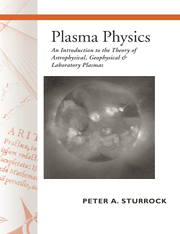Book contents
- Frontmatter
- Contents
- Preface
- 1 Introduction
- 2 Basic concepts
- 3 Orbit theory – uniform fields
- 4 Adiabatic invariants
- 5 Orbit theory
- 6 Electromagnetic waves in a cold electron plasma
- 7 Electromagnetic waves in an electron-ion plasma
- 8 Two-stream instability
- 9 Electrostatic oscillations in a plasma of nonzero temperature
- 10 Collision theory
- 11 MHD equations
- 12 Magnetohydrodynamics
- 13 Force-free magnetic-field configurations
- 14 Waves in MHD systems
- 15 Magnetohydrodynamic stability
- 16 Variation principle for MHD systems
- 17 Resistive instabilities
- 18 Stochastic processes
- 19 Interaction of particles and waves
- Appendix A Units and constants
- Appendix B Group velocity
- Appendix C Amplifying and evanescent waves, convective and absolute instability
- References
- Author index
- Subject index
17 - Resistive instabilities
Published online by Cambridge University Press: 05 June 2012
- Frontmatter
- Contents
- Preface
- 1 Introduction
- 2 Basic concepts
- 3 Orbit theory – uniform fields
- 4 Adiabatic invariants
- 5 Orbit theory
- 6 Electromagnetic waves in a cold electron plasma
- 7 Electromagnetic waves in an electron-ion plasma
- 8 Two-stream instability
- 9 Electrostatic oscillations in a plasma of nonzero temperature
- 10 Collision theory
- 11 MHD equations
- 12 Magnetohydrodynamics
- 13 Force-free magnetic-field configurations
- 14 Waves in MHD systems
- 15 Magnetohydrodynamic stability
- 16 Variation principle for MHD systems
- 17 Resistive instabilities
- 18 Stochastic processes
- 19 Interaction of particles and waves
- Appendix A Units and constants
- Appendix B Group velocity
- Appendix C Amplifying and evanescent waves, convective and absolute instability
- References
- Author index
- Subject index
Summary
Introductory remarks
In previous chapters, we have considered microscopic instabilities, such as the two-stream instability, and MHD instabilities. The third major category of instability is that of ‘resistive instabilities.’ They differ from two-stream instabilities in that they may be treated by fluid equations, and they differ from MHD instabilities in that they are due essentially to the fact that the resistivity is nonzero. A nonzero resistivity allows the magnetic-field lines to move independently of the plasma, so that the ‘frozen flux theorem’ is not applicable in this context. A crucial consequence of this effect is that ‘magnetic reconnection,’ shown schematically in Fig. 17.1, is allowed. In addition, field lines can ‘vanish.’ Consider, for instance, the azimuthal magnetic field set up in a linear pinch. If the resistivity is nonzero, the current will dissipate. As a result, the circular field lines will shrink in diameter and the innermost loops will shrink to a point and disappear (see Fig. 17.2). If there is no external energy supply, the decrease in magnetic energy is converted into joule heating.
Current sheet configuration
The resistive instability that is of special importance in astrophysics is the ‘tearing-mode’ instability that can develop in a current sheet configuration. We shall find that this instability leads to development, in a field configuration of the type shown in Fig. 17.3(a), of ‘magnetic islands,’ as shown in Fig. 17.3(b).
Information
- Type
- Chapter
- Information
- Plasma PhysicsAn Introduction to the Theory of Astrophysical, Geophysical and Laboratory Plasmas, pp. 272 - 287Publisher: Cambridge University PressPrint publication year: 1994
